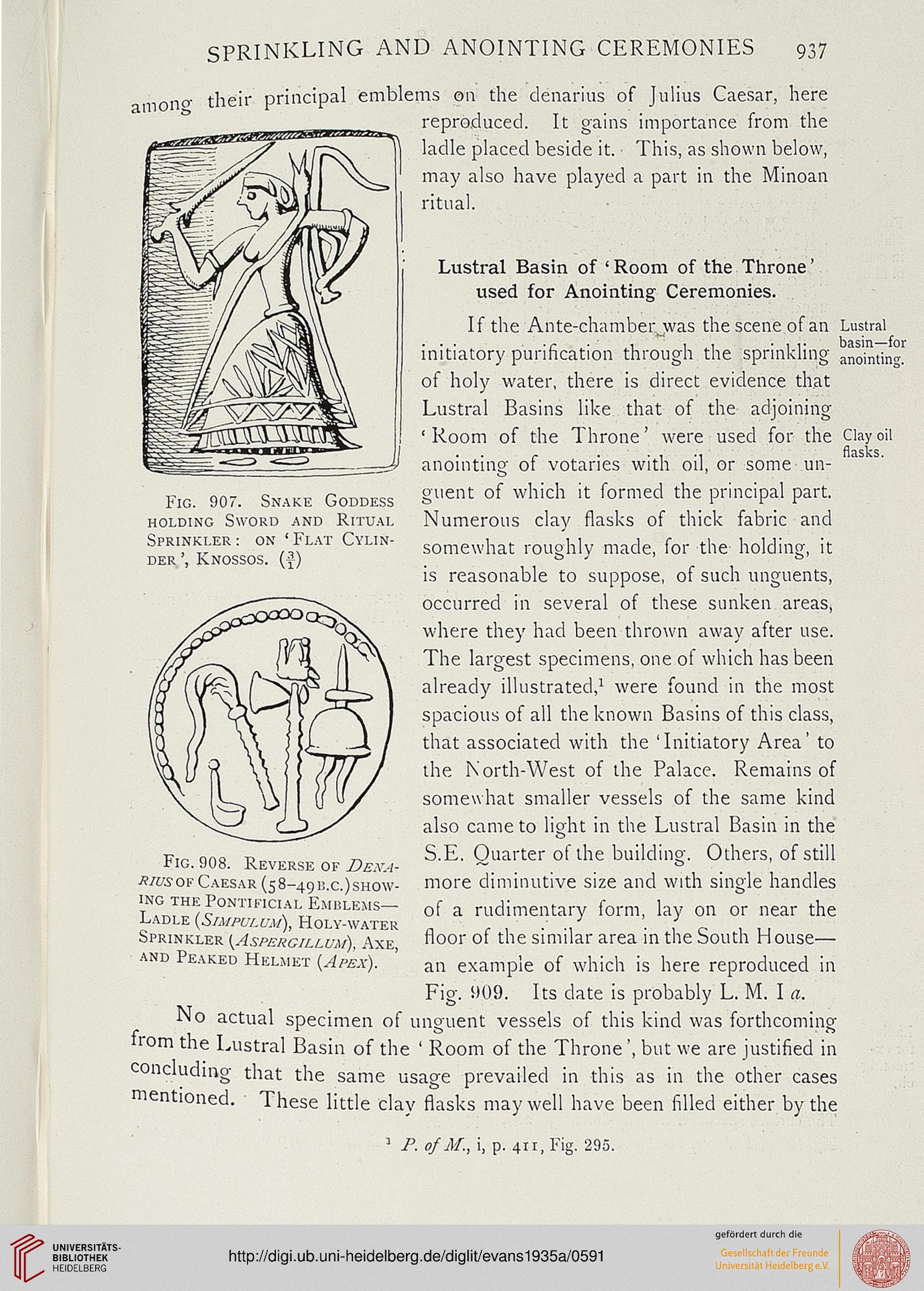SPRINKLING AND ANOINTING CEREMONIES
937
Fig. 907. Snake Goddess
holding Sword and Ritual
Sprinkler : on ' Flat Cylin-
der', Knossos. (f)
noil0' their principal emblems on the denarius of Julius Caesar, here
reproduced. It gains importance from the
ladle placed beside it. ■ This, as shown below,
may also have played a part in the Minoan
ritual.
Lustral Basin of ' Room of the Throne'
used for Anointing Ceremonies.
If the Ante-chamber was the scene of an
initiatory purification through the sprinkling
of holy water, there is direct evidence that
Lustral Basins like that of the adjoining
'Room of the Throne' were used for the
anointing of votaries with oil, or some un-
guent of which it formed the principal part.
Numerous clay flasks of thick fabric and
somewhat roughly made, for the holding, it
is reasonable to suppose, of such unguents,
occurred in several of these sunken areas,
where they had been thrown away after use.
The largest specimens, one of which has been
already illustrated,1 were found in the most
spacious of all the known Basins of this class,
that associated with the 'Initiatory Area' to
the North-West of the Palace. Remains of
somewhat smaller vessels of the same kind
also came to light in the Lustral Basin in the
S.E. Quarter of the building. Others, of still
more diminutive size and with single handles
of a rudimentary form, lay on or near the
floor of the similar area in the South House—
an example of which is here reproduced in
Fig. 009. Its date is probably L. M. I a.
No actual specimen of unguent vessels of this kind was forthcoming
from the Lustral Basin of the ' Room of the Throne ', but we are justified in
concluding that the same usage prevailed in this as in the other cases
mentioned. These little clay flasks may well have been filled either by the
Lustral
basin—for
anointing.
Clay oil
flasks.
Fig. 908. Reverse op Dena-
kws of Caesar (5 8-49 B.C.) show-
ing THE PONTIFICIAL EMBLEMS—
Ladle (Simpulum), Holy-water
Sprinkler {Aspbrgillum), Axe,
and Peaked Helmet {Apex).
P. of M., i, p. 411, Fig. 295.
937
Fig. 907. Snake Goddess
holding Sword and Ritual
Sprinkler : on ' Flat Cylin-
der', Knossos. (f)
noil0' their principal emblems on the denarius of Julius Caesar, here
reproduced. It gains importance from the
ladle placed beside it. ■ This, as shown below,
may also have played a part in the Minoan
ritual.
Lustral Basin of ' Room of the Throne'
used for Anointing Ceremonies.
If the Ante-chamber was the scene of an
initiatory purification through the sprinkling
of holy water, there is direct evidence that
Lustral Basins like that of the adjoining
'Room of the Throne' were used for the
anointing of votaries with oil, or some un-
guent of which it formed the principal part.
Numerous clay flasks of thick fabric and
somewhat roughly made, for the holding, it
is reasonable to suppose, of such unguents,
occurred in several of these sunken areas,
where they had been thrown away after use.
The largest specimens, one of which has been
already illustrated,1 were found in the most
spacious of all the known Basins of this class,
that associated with the 'Initiatory Area' to
the North-West of the Palace. Remains of
somewhat smaller vessels of the same kind
also came to light in the Lustral Basin in the
S.E. Quarter of the building. Others, of still
more diminutive size and with single handles
of a rudimentary form, lay on or near the
floor of the similar area in the South House—
an example of which is here reproduced in
Fig. 009. Its date is probably L. M. I a.
No actual specimen of unguent vessels of this kind was forthcoming
from the Lustral Basin of the ' Room of the Throne ', but we are justified in
concluding that the same usage prevailed in this as in the other cases
mentioned. These little clay flasks may well have been filled either by the
Lustral
basin—for
anointing.
Clay oil
flasks.
Fig. 908. Reverse op Dena-
kws of Caesar (5 8-49 B.C.) show-
ing THE PONTIFICIAL EMBLEMS—
Ladle (Simpulum), Holy-water
Sprinkler {Aspbrgillum), Axe,
and Peaked Helmet {Apex).
P. of M., i, p. 411, Fig. 295.





